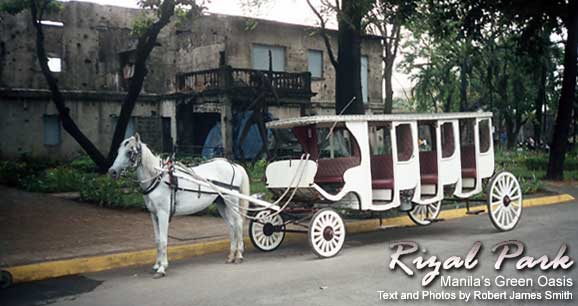

Manila, the capital and largest city in the Philippines, is a modern bustling metropolis in almost every respect.
In parts of the city, it seems that everywhere one looks, there’s a veritable sea of concrete, steel and glass towers.
In this urban jungle though, there is one major green space, located downtown on the edge of Manila Bay.
Rizal Park
Rizal Park is a large rectangular space stretching 1,600 feet (500 m) long and 800 feet (250 m) wide. It extends from Roxas Boulevard (which runs parallel to Manila Bay) in the west to Taft Avenue in the east.
To the north of the park is the elegant green-roofed Manila Hotel and the Intramuros, the Old Spanish colonial part of Manila.
Across the street from Roxas Boulevard is another large open area, the Parade Ground. It adds to this open oasis in an otherwise crowded downtown core.
In past days, the park, also known as Luneta, was a place where the upper classes conducted their ritualistic evening promenades to see and be seen.
These days, the park attracts almost all types, from early morning joggers to aerobic and martial arts enthusiasts to families enjoying a day outing.
Vendors of all types are found throughout the park, hawking film, colorful balloons and various snacks, among other things.
In the evening, lovers, the young, and the young at heart, find both a suitably romantic setting and privacy in the parks confines.
Few attractions in the Park
There are quite a few attractions within the park and to fully explore and appreciate it all takes at least a day. At the eastern edge near Taft Avenue is a large three-dimensional map of the Philippines.
Just past this is a roller skating rink. North of the rink, the Museum of the Filipino People can be found. The National Library rests on the southern edge.

Past the museum on the North Side is the planetarium. It’s flanked by two enclosed gardens, one Japanese, the other Chinese. Both of these offer some seclusion for those seeking it.
The most striking thing about the park, however, is its namesake. José Rizal was a Filipino doctor, poet, scholar, and most of all, a patriot.
He was one of the leaders of the independence movement from Spain in the later half of the 19th century.
Unlike many of his predecessors who advocated revolution (there were some 100 revolts and rebellions prior to this), Rizal advocated peaceful means for independence.
The Spanish authorities arrested and imprisoned him for his actions, and on December 30, 1896, executed him by firing squad.
On the eve of his execution, Rizal penned the stirring poem “Mi Último Adiós” (“My Last Farewell”), a work detailing his love for his land, his people, and the desire to live free.
Rather than stopping the independence movement as authorities had hoped, it ensured that it would succeed, as more and more Filipinos joined the cause of independence and opposition to Spanish rule.
In 1898, with assistance from the United States, the Philippines achieved independence from Spain. It would take many more years and a few setbacks, but full independence was finally achieved in 1946.

Rizal Monument
At the western edge of the park near Avenue Roxas is the “Rizal Monument,” a 50-foot (15 m) high granite obelisk.
Several large panels flank the monument on which “Mi Último Adiós” has been written in English, Spanish and Tagalog (one of the major languages spoken in the Philippines and the basis for Filipino).
Filipino Marines in immaculate uniforms guard over this imposing monument.
North of the monument, near the Chinese Garden, is a small enclosed section. This is the actual site of Rizal’s execution. Larger-than-life dioramas show his final days in captivity and his death at the hands of his own countrymen.
The Spanish authorities used Filipino, and not Spanish soldiers, for his firing squad. As the diorama shows, Rizal’s last act of defiance was to face away from his executioners.
The statues in this park are more than a permanent tableau to this important page in Filipino history. They are used in regular sound and light shows that tell Rizal’s story.
Entrance to the Rizal Diorama is 10 pesos (US$ 0.18) and the times for the light and sound shows are posted at the ticket kiosk.
Exiting from this small and somber enclosure back into the park proper, one only has to look at the crowds of Filipinos enjoying themselves in simple daily pleasures to realize that a park like this really is a fitting memorial to this man.
If You Go
Philippine Department of Tourism
www.tourism.gov.ph
Philippine Convention & Visitors Corporation
www.dotpcvc.gov.ph
